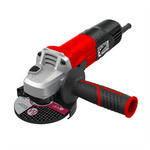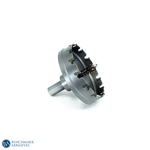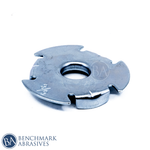
Flap Disc vs. Wire Wheel

When preparing a surface material for welding and post-weld washing, it is important to remove all surface contaminants. It saves time and money to remove as little material as possible between weld passes, as any material removed would inevitably need to be replaced by the most costly filler metal consumable.
During pre-weld surface preparation, removing too much of the base material may also influence the penetration of the weld, affecting the strength and integrity of the finished weld.
Choose the best surface preparation flap disc or wire wheels for cleaning the work surface. The correct tool provides effective, efficient results and helps you to spend more welding time and cleaning and fixing less time.
Flap Disc Vs. Wire Wheel
There is a large difference in the efficiency and function of the Wire wheel and flap disc on the basis of abrasive material. Abrasive materials coated flap discs are used for the removal of extra-base material, whereas wire wheel brushes are strongly preferred for surface preparation and to remove slag and scale.
Coated abrasive flap disc is designed for numerous applications such as stock removal, edge beveling, chamfering, and weld grinding and blending. Likewise, a wire wheel brush is the best option in the application of base material preservation during surface preparation and weld cleaning.
Common Tools in Welding Applications
The three most common tools used for surface preparation and cleaning in welding applications are:
- Bonded abrasives/grinding wheels
- Coated abrasives/flap discs
- Wire brushes and wheels
Bonded Abrasives/Grinding Wheels
The output of a bonded abrasive-based grinding wheel is determined by a combination of the grain type, grain size, and bonding agents (resins and adhesives).
In general, bonded abrasives are more vigorous and easier to extract material. A skilled operator is needed to avoid damage, gouging, and undercutting. Grinding wheels mainly consist of aluminum oxide, silicon carbide, zirconia alumina, ceramic alumina, or a combination of such grains.
The most common are aluminum oxide grinding wheels that are perfect for many applications. Products made with a ceramic and zirconia alumina combination cost more but usually have a larger overall life and removal of material. Materials such as armed steel, structural steel, cast iron, and alloys are good choices for them.
Coated Abrasives/Flap Discs
Coated abrasives flap discs consist of the same grain types as those used in bonded abrasives. Instead of the rough grinding wheel found on bonded abrasives, Coated abrasives bind the abrasive grains to a backing cloth, which is most commonly cotton, polyester, or blended backing. It is possible to cut this abrasive cloth into smaller flaps and radially layer it to form a flap disc. It is this layered structure that gives a much smoother, more flexible feel to flap discs.
As the grains exhaust, the flaps are built and placed to wear away, revealing new, clean, and sharp grains below. The vigorous cutting and grinding of flap discs are most efficient for grinding wheels; however, they often allow blending and finishing work, which is essential when the material needs to be painted, primed, or powder-coated.
Wire Wheels and Brushes
They are used for cutting, brushing, deburring, polishing, and finishing the surface. Wire wheels are motor-driven and may have an arbor hole to support their use with grinding machinery, a form of the power brush.
Wire wheels are required to clean weld and other materials from the surface. The tips of wire brushes function like a small hammer for hitting and work surface preparation. To obtain maximum efficiency from the power brush, optimum pressure must be applied. The unnecessary pressure can flex and bend the wires. This can lead to premature breakage of the wire and drastically reduce brush life.
Crimped-wire brushes are mainly used for paint and rust removal and deburring. It works less aggressively and more conformably. Crimped-wire brushes offer a smooth finish for surface preparation and paint adhesion.
Wheel brushes are designed to operate parallel to the work surface and are ideally suited to surface areas that are smaller and tighter. Because of their ability to clean a wider area in a single pass, cup brushes are ideal for covering larger, broader surface areas.
How To Choose The Right Tool
While selecting flap discs and wire wheels, the following are the factors to consider:
-
Material and Application: Material and application are two important factors to consider when choosing between flap discs and wire wheels. Always look for the material and specific application you are working on before selecting the tools. Flap discs are mostly suitable for projects requiring accuracy and finishing, while wire wheels are suitable for projects requiring aggressive material removal.
-
Desired surface finish: This is another factor to consider when choosing between flap disc and wire wheels. Flap disc produces a more accurate and smooth finish compared to wire wheels because of its fine abrasive grits, which offer more precise control over the finishing process, and better control at removing material due to its overlapping flaps. Lastly, they are more flexible and comfortable to use. Wire wheels, on the other hand, produce a rough and textured surface due to their aggressive bristles. Hence, wire wheels are perfect for removing rust or paint.
-
Safety: In terms of safety, wire wheels are highly prone to danger when compared to flap discs because of their aggressive bristles. However, they both require careful handling to prevent severe accidents. Ensure to wear appropriate safety gears for enhanced protection.
-
Durability and cost: Flap discs are highly durable compared to wire wheels, despite being high initially. It features multiple layers of abrasive material, which makes it durable. Wire wheels, on the other hand, are usually more economical. With heavy use, it tends to break quickly and require frequent replacement, which makes it less durable.



































































